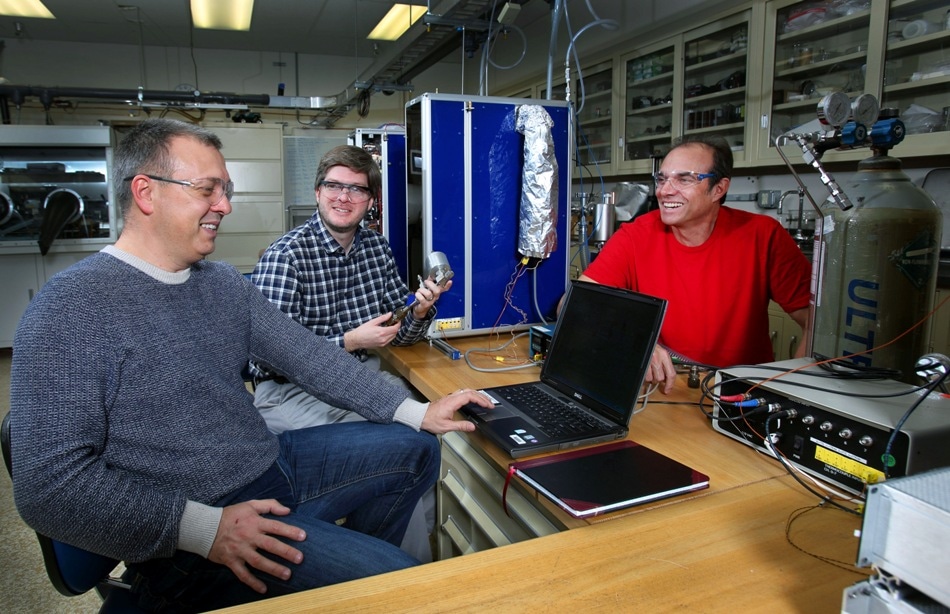Feb 27 2017
 Sandia National Laboratories chemist Vitalie Stavila, left, talks to Lawrence Livermore National Laboratory computational scientist Brandon Wood, center, and Sandia chemist Lennie Klebanoff. (Photo by Dino Vournas)
Sandia National Laboratories chemist Vitalie Stavila, left, talks to Lawrence Livermore National Laboratory computational scientist Brandon Wood, center, and Sandia chemist Lennie Klebanoff. (Photo by Dino Vournas)
The concept of going small to win big was applied in an approach developed by a multilab, interdisciplinary team in which they used nanoparticles and a unique nanoconfinement system to formulate a method to modify hydrogen storage properties.
This finding could facilitate the development of high-capacity hydrogen storage materials capable of fast refueling, thus enhancing the performance of up and coming hydrogen fuel cell electric vehicles.
Sandia National Laboratories, Lawrence Livermore National Laboratory (LLNL), the National Institute of Standards and Technology and Mahidol University in Bangkok, Thailand, partnered on the research, which was published February 8 in the Advanced Materials Interfaces journal.
The research was funded by the Department of Energy’s (DOE) Fuel Cell Technologies Office and the Boeing Co.
Accelerating the Uptake and Release of Hydrogen
An electrochemical reaction between oxygen and hydrogen within a fuel cell powers hydrogen fuel cell vehicles.
Oxygen can be taken from air, but the hydrogen has to be stored separately on the vehicle. Hydrogen is stored as a high-pressure gas in current fuel cell electric vehicles.
A solid material can act like a sponge for the absorption and discharge of hydrogen, which in chemical terms is hydrogenation and dehydrogenation. Therefore using such a hydrogen storage material could boost the amount of hydrogen that can be stored. The material should be able to store sufficient hydrogen for the vehicle to run a minimum of 300 miles before refueling.
There are two critical problems with existing sponges for hydrogen storage. Most can’t soak up enough hydrogen for cars. Also, the sponges don’t release and absorb hydrogen fast enough, especially compared to the five minutes needed for fueling.
Vitalie Stavila, Chemist, Sandia National Laboratories
Stavila explained, in this research the interdisciplinary research team worked closely on the synthesis, characterization, and modeling so as to enhance the properties of lithium nitride, a promising hydrogen storage sponge. The team also developed a primary understanding of why nanosizing enhances this material’s hydrogen storage properties.
Confining the Space
Mahidol University graduate student Natchapol “Golf” Poonyayant approached Sandia with the idea of using nanoconfinement to improve hydrogen storage reactions in nitrogen-containing compounds. Working with the Sandia researchers, Poonyayant, his adviser, Pasit Pakawatpanurut, and fellow Mahidol student Natee “Game” Angboonpong discovered that liquid ammonia could be applied as a mild and efficient solvent for introducing nitrogen and metals into the pockets of carbon nanoparticles, creating nanoconfined lithium nitride particles.
The new material that was created based on Poonyayant’s idea showed some unusual and unanticipated properties. First, the quantity of lithium nitride in the carbon nanoparticle host was fairly high for a nanoconfined system, approximately 40%. Second, the nanoconfined lithium nitride absorbed and discharged hydrogen more quickly than the bulk material.
Additionally, once the lithium nitride had been hydrogenated, it also discharged hydrogen in only a single step and much quicker than the bulk system that required two steps.
In other words, the chemical pathways for both hydrogen absorption and release in this hydrogen storage material were dramatically changed for the better.
Lennie Klebanoff, Chemist, Sandia National Laboratories
Understanding the Puzzle
To understand the mechanism accountable for this improvement in a better manner, the Sandia researchers approached computational scientist Brandon Wood of LLNL, a leading authority in the theory of solid-state reactions. Wood and his LLNL colleagues Tae Wook Heo, Jonathan Lee and Keith Ray discovered that the reason for the unusual behavior was the energy linked with two material interfaces.
As the lithium nitride nanoparticles measure just 3 nm in width, even the smallest energetically adverse process is avoided in the hydrogen storage properties. For lithium nitride nanoparticles undergoing hydrogenation reactions, the avoidance of adverse intermediates - additional steps in the chemical process - boosts efficiency.
Opting for the path of minimal resistance, the material undergoes a single-step path to complete hydrogenation. Likewise, once hydrogenated, the nanoparticles discharge hydrogen by the lowest energy pathway available, which in this case is direct hydrogen discharged back to lithium nitride.
In this way, the nanointerfaces drive the hydrogen storage properties when the materials are made very small, for example with nanoconfinement. The purposeful control of nanointerfaces offers a new way to optimize hydrogen storage reaction chemistry.
Brandon Wood, Computational Scientist, LLNL
The Next Step
According to the Sandia and LLNL researchers, the following step is to additionally understand how the hydrogenated and dehydrogenated phases of lithium nitride change at the nanoscale. This is a tough challenge to the team, as it requires imaging various chemical phases within a particle that is just several nanometers wide.
The team will utilize the capabilities within the DOE’s Hydrogen Storage Materials Advanced Research Consortium (HyMARC), led by Sandia and comprising of more scientists from LLNL and Lawrence Berkeley National Laboratory. The team hopes to use spatially resolved synchrotron radiation from LBNL’s Advanced Light Source to investigate interface structure and chemistry.
Moreover, since the nanoporous carbon host is “dead weight” from a hydrogen storage standpoint, the team is looking at ways to “lighten the load” and discover carbon materials with extra nanopockets for a particular carbon mass.
We are thrilled with this technical advance and excited to take on the work ahead. But it’s bittersweet. Golf, who inspired this work and conducted many of the syntheses, died tragically at the age of 25 during the writing of this paper. The world has lost a talented young man and we have lost a dear friend whom we miss. This work and its published account are dedicated to Golf and his family.
Lennie Klebanoff, Chemist, Sandia National Laboratories